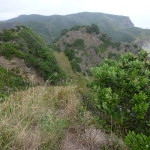
In 1948, two scientists came to the coastal bluffs along the Tasman Sea just west of Auckland, and for the first time listened to the sounds of stars outside the Milky Way. It’s likely that few visitors now head here to listen to the music of the spheres, and the stars. Most aim to find a readily accessible, more peaceful distraction from the busy city center, rather from beyond the galaxy.
To the immediate west of Auckland, the suburbs quickly give out and yield to the Waitakere Ranges (why – TACK – uhree, as we were instructed) and, just beyond, the Tasman – about a 45 minute drive away from the CBD.

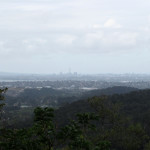
Along the ridge of the Waitakere, a two-lane scenic drive twists for twenty kilometers up to about 475 meters (1500 feet) high. Viewpoints open up regularly giving vistas east toward Auckland, the bay and its iconic sky tower, or west across the Tasman. We could see several dammed lakes collecting water for the city and an expansive wild rainforest that has been regenerating for a century since the end of logging and farming here.
The most spectacular viewpoint was a 360 degree prospect atop Mount Pukematekeo. The hills on one side swathed in rich rainforest, the bright reservoir reaching into the crevasses below; Auckland at the apex of Manukau Harbour on the other side, reminding you how close it is.
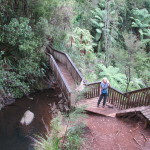
From the ridge along the Scenic Drive, numerous tracks split off for extended bush walks, lookout points and attractive falls. For about three hours, we did a loop that began with a steep descent to Fairy Falls, itself a fifty meter drop that becomes more and more enchanting as you scramble down the rocks and wooden stairsteps beside it.
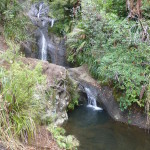
On the trail, we were charmed by the stillness of the rainforest, interrupted a bit by the regular squeaks of native Tuis, the beauty of the falls even with low water flow, and discoveries along the way. We even walked into a film shoot downstream of the falls, in the most remote part of the track. Cut! The filmmakers explained they were creating an entry on Maori culture for a film competition. But we didn’t quite understand why the main actor was a black-haired, black garbed woman with gleaming white makeup.

The scenic drive and its tracks are very inviting for those who seek bush walks or views. However, the main reason people come here from the city are the striking black beaches along the coast – at Karekare, Piha, Te Henga and Muriwai. The sea is often rough here, perfect for surfing, but there are plenty of spots to swim or just enjoy the impressive sprawl of the coastline.
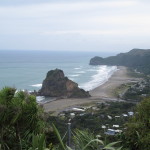
At Piha, the huge beach is dominated by massive Lion Rock plunked right down in the middle, which looks a bit like a lion at the right light and angle. Other interesting rocks erupt out of the sand nearby. It’s a great place for relaxing and picnicking.
The attraction of this area is readily apparent. So it’s no surprise to find several clusters of grand houses along the scenic drive, or on the roads snaking off toward Piha and the other tiny towns along the shore. Watching the steady evening traffic heading here from the city suggests many even commute daily to the city for work. That includes the owners of the apartment we occupied above Piha, people who fully enjoy the significant life-style distance from the city, while comforted by the advantages of proximity.
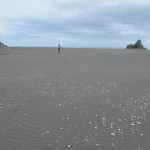
During our stay, we explored two other huge beaches, empty of all but a few people on a weekday before Easter. The first was at Karekare, where tiny rocky islands stuck out of the sand and the inhospitable wind kept trying to sandblast us as we ate lunch.
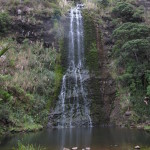
Nearby we had seen the Karekare Falls, a huge drop of water into a pool and the picturesque setting for a wedding which ended just as we arrived. As we left, we met a small talkative tour group of Americans and Aussies, filling in a day between cruises from Oz to New Zealand and then on to Hawaii. One of them asked if snow fed the falls – so we knew he was not local.

We had hiked here for a couple of hours along the headlands and through bush just north of Karekare, braving some demanding uphill and downhill climbs. All worth it, as we were rewarded with vertiginous views from the cliff faces fronting the Tasman Sea, staring out at unreachable coves of black sand or the long stretch of Karekare beach.
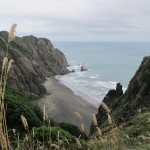
Fittingly , atop these cliffs where a plaque now commemorates the event, those New Zealand scientists listened to the stars beyond.
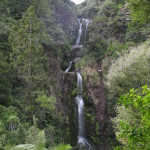
An even prettier falls started our last day here, back up within the ranges, after a fairly short and easy going track. Kitekite Falls delights the eye with six cascading levels as the water drops about 80 meters from the top with a final delicate curtain of water as it reaches the ground. Nancy braved the chilly water at the pool below, but she found it too shallow and rocky to try swimming. We just enjoyed the charm of the place instead.
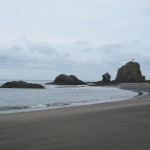
Then we headed to Whatipu at the southwestern corner of West Auckland to explore its shoreline. As we describe in our previous post, that beach was stunning, austere and yet strangely attractive – wondrous to wander barefoot in its wet, loam-like black sand. But a far different, more unusual and challenging experience there is what we will most recall (click here to read the post).
On three cloudy days and nights, we neither saw nor heard the distant stars. But we did discover the wildness and quietude of Auckland’s western edge. It’s not touristy or full of attractions as the Pacific coast immediately to the north of the city, Instead, for a day or three, you can at least escape the bounds of the nearby city – whether you dawdle at sea level on its beaches or meander up on its ridges and bluffs.
(Also, for more pictures from New Zealand, CLICK HERE to view the slideshow at the end of the New Zealand itinerary page.)


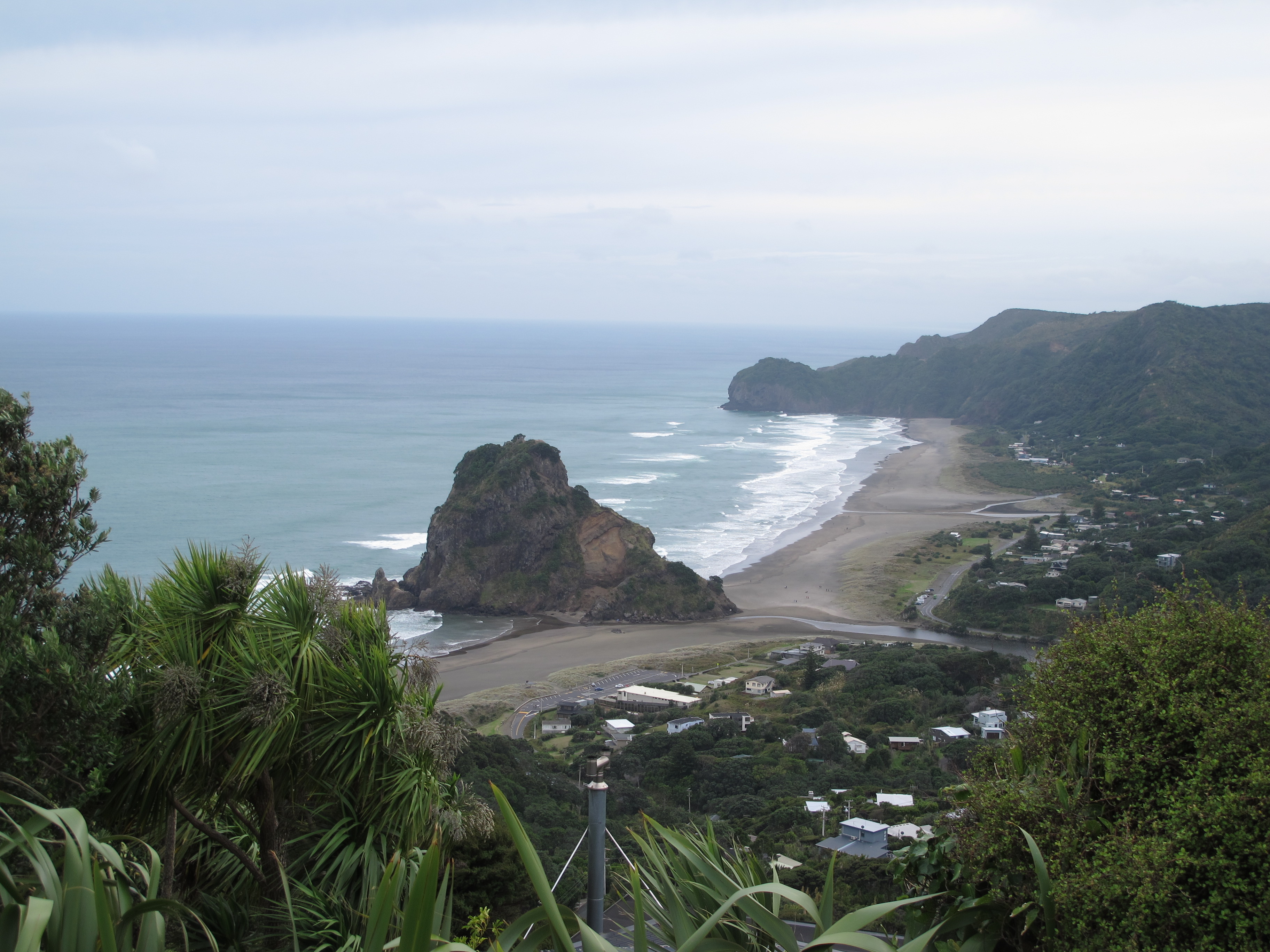
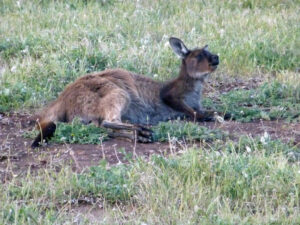
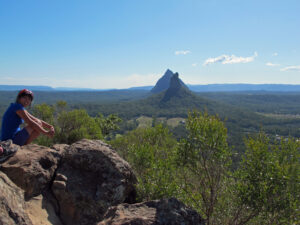
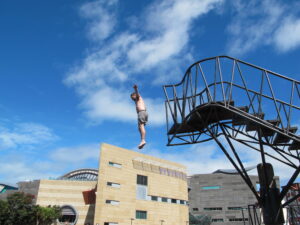
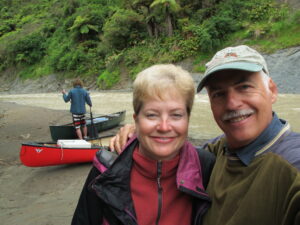
I grew up in the south of Auckland but my family all lives in the west now and regularly take advantage of the Waitakere trails. New Zealand certainly is a gorgeous country and I love returning even though my life is centered around the west coast of the US now. As a teenager me and my friends would surf at Piha and Maori Bay. Makes me proud when I hear of others that have traveled to NZ and enjoyed it.
We hated to leave NZ, and miss the countryside and the people. That western shore was a very pleasant surprise, and we would have gone back many times if we had stayed longer. But adventures call!